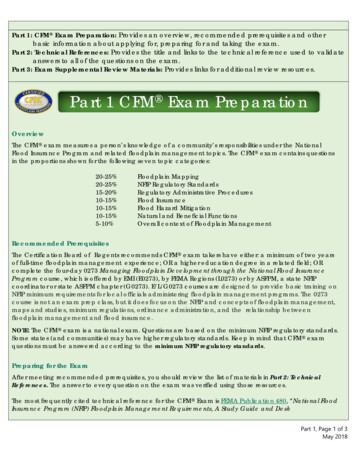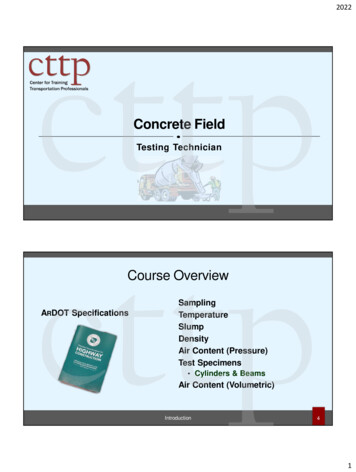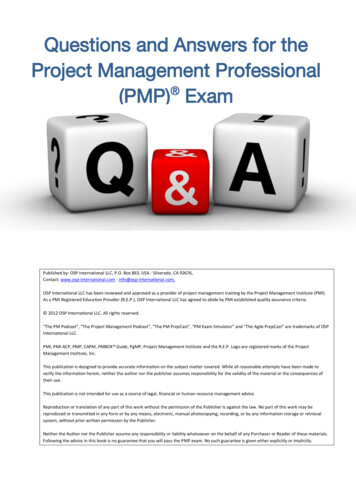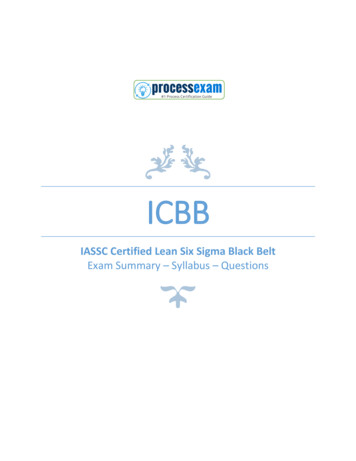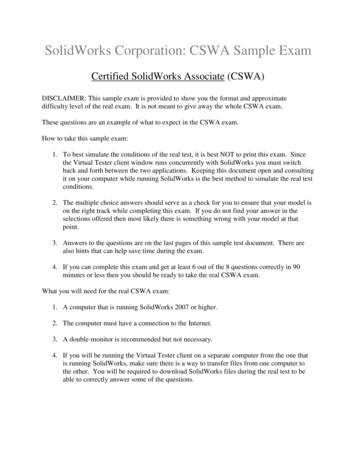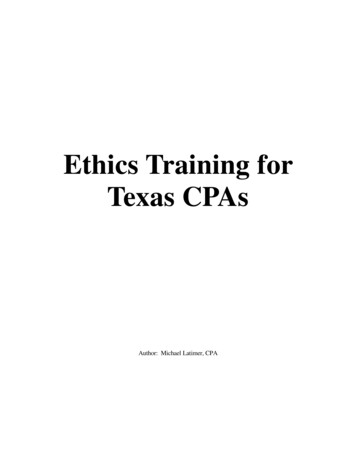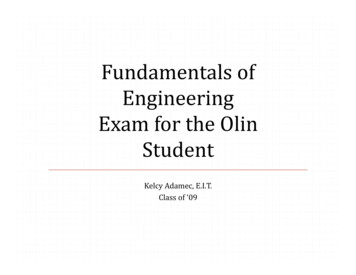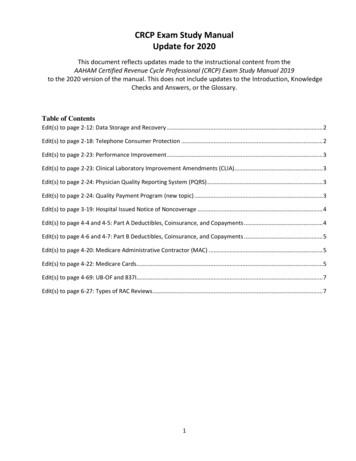
Transcription
CRCP Exam Study ManualUpdate for 2020This document reflects updates made to the instructional content from theAAHAM Certified Revenue Cycle Professional (CRCP) Exam Study Manual 2019to the 2020 version of the manual. This does not include updates to the Introduction, KnowledgeChecks and Answers, or the Glossary.Table of ContentsEdit(s) to page 2-12: Data Storage and Recovery . 2Edit(s) to page 2-18: Telephone Consumer Protection . 2Edit(s) to page 2-23: Performance Improvement . 3Edit(s) to page 2-23: Clinical Laboratory Improvement Amendments (CLIA). 3Edit(s) to page 2-24: Physician Quality Reporting System (PQRS) . 3Edit(s) to page 2-24: Quality Payment Program (new topic) . 3Edit(s) to page 3-19: Hospital Issued Notice of Noncoverage . 4Edit(s) to page 4-4 and 4-5: Part A Deductibles, Coinsurance, and Copayments . 4Edit(s) to page 4-6 and 4-7: Part B Deductibles, Coinsurance, and Copayments . 5Edit(s) to page 4-20: Medicare Administrative Contractor (MAC) . 5Edit(s) to page 4-22: Medicare Cards. 5Edit(s) to page 4-69: UB-OF and 837I. 7Edit(s) to page 6-27: Types of RAC Reviews . 71
Note:Throughout the manual, “I” icons flagging content for institutions have been replaced with “F” iconsrepresenting facilities. “P” icons now flag content for provider practices. But all the information inthe study manual could appear on your exam, regardless of whether it is flagged for facilities orprovider practices. The certification you are testing for and its exam are no longer separated byfacility versus provider practice distinction.Note:Unless otherwise stated, information in yellow below has been inserted and information struckthrough has been deleted.Edit(s) to page 2-12: Data Storage and RecoveryYet another element of HIPAA was to require providers to prepare for potential disaster by requiring a backup plan for data storage and recovery. The need for this became evident following Hurricane Katrina and thedestruction of entire hospitals and patient records along the Gulf Coast. The effects of this catastrophe arestill being dealt with today. The lessons learned with Katrina helped hospitals that were faced with HurricaneSandy in 2012 have helped hospitals that face hurricanes and other natural disasters.These back-up plans are also critical in responding to a growing digital extortion technique. Criminals areincreasingly using various methods to hijack patient data and hold it hostage for ransom. When this happens,providers must weigh the decision to pay a ransom to the hackers to restore their data versus the time andeffort needed to retrieve their own back-up files.Edit(s) to page 2-18: Telephone Consumer ProtectionThe Telephone Consumer Protection Act (TCPA) restricts telephone solicitations (in other words,telemarketing) and the use of automated tele-phone equipment. The TCPA prohibits contact with a debtoron a cell phone using automated dialing equipment without express consent and limits the use of artificial orprerecorded voice messages, SMS (Short Message Service, or text) messages, and fax machines. It alsospecifies several technical requirements for fax machines, auto dialers, and voice messaging systems —principally requiring identification and contact information of the entity using the device to be contained inthe message.The TCPA restricts the use of automated dialing equipment when contacting a wireless telephone or anytelephone number for which the individual may be charged for the call unless prior express consent has beenobtained. Automated dialing equipment is defined as equipment with the ability or the potential ability(including through the addition of software) to store or produce telephone numbers and make calls using arandom or sequential number generator. The basic functions of automated dialing equipment are to dial anumber without human intervention and to be able to dial thousands of numbers in a short period of time.In addition, the TCPA requires prior express consent for any call, auto-mated or manual, made to a wirelessphone. When a patient provides a wireless phone number to a provider, this is considered prior expressconsent or permission as long as the patient did not provide any instructions limiting calls to the giventelephone number and the provider makes only those calls related to the original consent.Thanks to the ongoing and continuing efforts of our industry, the Federal Communications Commissionadopted conditions (FCC 15-72) for calls made by or on behalf of a healthcare provider. Some of thoseconditions include: Text message and voice calls should only be sent to the wireless tele-phone number that has beenprovided by the patient.2
Any voice calls or text messages must include the name and contact information of the healthcareprovider and must comply with HIPAA privacy rules. All calls should be one minute in length or less, and text messages should be no longer than 160characters. Limit provisions state that healthcare providers can initiate only one call or text per day and no more thanthree per week. An opt-out must be offered and, should a patient elect to use it, the healthcare provider must honor theopt-out request immediately.Edit(s) to page 2-23: Performance ImprovementFederal regulations also address two major areas of healthcare performance improvement: laboratorycertification and quality payment reporting.Edit(s) to page 2-23: Clinical Laboratory Improvement Amendments (CLIA)5. Certificate of AccreditationThe CLIA number must be reported on the claim form when the provider is a Medicare participating provider.NOTE: There are two states that are exempt from CLIA certification. They are Washing-ton and New York.Edit(s) to page 2-24: Physician Quality Reporting System (PQRS)(The entire PQRS section has been deleted.)Edit(s) to page 2-24: Quality Payment Program (new topic)The Medicare Access and CHIP Reauthorization Act of 2015 (MACRA) ended the Sustainable Growth Rate(SGR) formula, which would have significantly cut payment rates for participating Medicare clinicians. MACRA requires us to implement an incentive program, the Quality Payment Program. There are two waysclinicians can choose to participate in the Quality Payment Program:1. The Merit-based Incentive Payment System (MIPS) – If you’re a MIPS eligible clinician, you’ll be subject toa performance-based payment adjustment through MIPS.2. Advanced Alternative Payment Models (APMs) – If you decide to take part in an Advanced APM, you mayearn a Medicare incentive payment for sufficiently participating in an innovative payment model.TIP: Detailed information regarding Value Based Programs can be found s/Value-Based-Programs.html.3
Edit(s) to page 3-19: Hospital Issued Notice of NoncoverageThe HINN is similar to an ABN in that it is a liability notice. HINNs affect providers submitting claims toMedicare Administrative Contractors (MACs) for hospital inpatient services. Hospitals provide HINNs tobeneficiaries prior to admission, at admission, or at any point during an inpatient stay if the hospitaldetermines that the items or services the beneficiary is receiving, or is about to receive, are not coveredbecause it is: Not medically necessary; Not delivered in the most appropriate setting; or Custodial in nature.Hospitals give HINNs to fee-for-service inpatient hospital beneficiaries who are due to receive specific diagnostic or therapeutic procedures that are separate from treatment covered / paid / bundled into theinpatient stay.Edit(s) to page 4-4 and 4-5: Part A Deductibles, Coinsurance, and CopaymentsMedicare Part AServiceInpatient hospital stay – Semiprivate room, meals, generalnursing, other hospital services,and supplies. This includes carein critical access hospitals, butdoes not include private dutynursing, television, or telephoneservice in the room if billedseparately. It also does notinclude a private room, unlessmedically necessary.Inpatient mental healthcare in anindependent psychiatric facility islimited to 190 days in a lifetime.Beneficiary ObligationDays 1 through 60*: Part A current year inpatient deductible2020 19 Amount 1,408 1,364 perspell of illness*Renewable during the next benefit periodDays 61 through 90*: 352 341 per dayPart A coinsurance (1/4 or 25% of current yearinpatient deductible)*Renewable during the next benefit periodDays 91 through 150*: 704 682 per dayPart A lifetime reserve (LTR, 1/2 or 50% ofcurrent year inpatient deductible)*Nonrenewable; hospitals alert patients when theyhave 5 days of coinsurance left so they can choosewhether to use their LTR daysSNF care – Semi-private room,meals, skilled nursing andrehabilitative services, and otherservices and supplies. (Patientsneed three midnights as aninpatient to qualify for Medicarecoverage in a SNF.)Days 1 through 20: No deductible or coinsuranceDays 21 through 100: 1/8 of current year inpatient deductible4 0 per benefitperiod 176 170.50 perday
Edit(s) to page 4-6 and 4-7: Part B Deductibles, Coinsurance, and CopaymentsMedicare Part BServiceMedical and other services –Doctors services (except forroutine physical exams);outpatient medical and surgicalservices; supplies; diagnostictests; ambulatory surgery centerfacility fees for approvedprocedures; and DME. Alsocovers second surgical opinions;outpatient physical,occupational, and speechtherapy; and outpatient mentalhealthcare.Beneficiary ObligationMedical and other services: Current year deductible, then coinsurance (20%of Medicare-approved amount, except in theoutpatient setting)Outpatient physical, occupational, and speechlanguage therapy services: 198 185 per year,then 20% ofMedicare-approvedamount20% of Medicareapproved amountCoinsuranceOutpatient mental healthcare: 2020 19 AmountCoinsurance20% of Medicareapproved amountEdit(s) to page 4-20: Medicare Administrative Contractor (MAC)Medicare Administrative Contractors (MACs) are the private firms that process Medicare Part A and Part Bmedical claims or DME claims for Medicare FFS beneficiaries. MACs were formerly known as fiscalintermediaries or carriers. MACs also serve as the primary operational contact for providers. They enrollproviders in the Medicare program, provide education on Medicare billing requirements, and answer bothprovider and patient inquiries.Currently there are 12 Part A / Part B MACs and four DME MACs jurisdictions in the program that processMedicare FFS claims based on the geographical location of the provider.Edit(s) to page 4-22: Medicare CardsNOTE: The Medicare Access and CHIP Reauthorization Act of 2015 required CMS to remove Social SecurityNumbers (SSNs) from all Medicare cards by 2019. The process of basing the previous Health Insurance ClaimNumber (HICN) on the patient's SSN violates HIPPA. Information such as member name and effective dateswill still be present on the Medicare card. Each person is assigned their own unique identifier, known as theMBI, Medicare Beneficiary Identifier. Starting January 1, 2020, you MUST submit claims using MBIs (with afew exceptions), no matter what date you performed the service. The new MBI will:As of April 2018, CMS began mailing new Medicare cards. The Medicare Access and CHIP Reauthorization Actof 2015 requires CMS to remove Social Security Numbers (SSNs) from all Medicare cards by 2019. Theprocess of basing the previous Health Insurance Claim Number (HICN) on the patient's SSN violates HIPPA.This change is important because CMS will be better able to protect private health care and financialinformation and protect federal health care benefits and service payments.The new identifier (known as the MBI, Medicare Beneficiary Identifier) will: Have the same number of characters (11) as the HICN5
Contain uppercase letters and numeric characters, but no special char-acters Occupy the same field on HICN transactions Be unique to each beneficiary (in other words, husband and wife have their own MBIs) Be easy to read and limit the possibility of misinterpretation (upper-case letters only and no commonlymisread letters S, L, O, I, B, and Z) Not contain inappropriate combinations of numbers or strings that may be offensive6
Edit(s) to page 4-69: UB-OF and 837IThe following are some examples of common codes found on a UB-04/837I: Type of Bill - a three-digit code where the first digit is Type of Facility; second digit is Bill Classification;and third digit is Frequency, such as:- 111 – Type of Facility: Hospital; Bill Classification: In Patient; Frequency: Admit through Discharge Condition Code – a two-digit code that clarifies an event or condition related to the bill that may affectpayer processing, such as:- 04 – Information only bill (i.e., HMO)Edit(s) to page 6-27: Types of RAC ReviewsRACs perform two three different types of reviews:1. Automated – The RAC merely identifies a potential issue and uses its database to find improperpayments. The provider is then given notification of denied claims. Automated reviews are generallybased on clear policies outlined in the law, regulations or guidance.2. Complex – The RAC requests medical records and makes its determination from them. These audits mayinvolve questions of medical necessity, proper documentation, and others where judgment is required.3. Prepayment – The RAC reviews claims prior to Medicare payment, based on preset criteria. (CMSlaunched prepayment reviews as part of a demonstration project effective in 2012 and limited to only afew states.)7
outpatient physical, occupational, and speech therapy; and outpatient mental healthcare. Medical and other services: Current year deductible, then coinsurance (20% of Medicare-approved amount, except in the outpatient setting) 198 185 per year, then 20% of Medicare-approved amount Outpatient physical, occupational, and speech-


